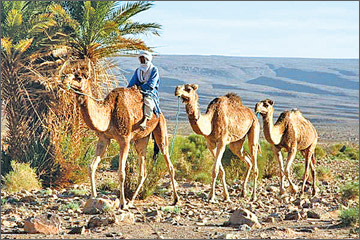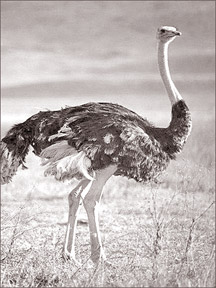Camel and Ostrich farming in Sri Lanka
Champa Fernando
The Deputy Minister of Livestock H R Mithrapala is interested in
importing camels and ostriches to farm here for their milk and eggs
respectively, mainly in order to diversify the diet of Sri Lankans,
particularly the Muslims.
|

Deputy Minister
H R Mithrapala |
He says there is “no food scarcity here in Sri Lanka” and what we now
need is to try “varieties, different types of things we’ve seen in the
world ... so especially the Muslim people in the country” and “tourists
can enjoy it.” (Camel milk and Ostrich eggs could fill Sri Lankan Food
Gap; Sunday, January 9, 2011 11:56 Sajithra Nithi Radio Australia). The
Deputy Minister says that the two dry zones of Sri Lanka could be used
for camel breeding and is of the view that since ostrich eggs “compared
to other eggs” . . . “are bigger and weight-wise . . . higher . . . we
can feed a family with one egg.” Should not it be considered how much an
ostrich would eat to grow and produce eggs as against the costs involved
for same with regard to a hen? With overheads, one ostrich egg may be
the price of one or two dozen chicken eggs.
Foreign species
He is also not too worried about introducing foreign species to the
country. He believes we must “experiment with these things.”
The camels and the ostriches are not going to keep their legs
crossed, so the multiplying two new animal species will most certainly
have an impact on our ecology and environment.
|

Camels to boost milk production. Picture courtesy: Google |
What then is going to happen to the surplus or the economically
unproductive animals? Cull them, create fresh abattoirs to kill them for
their meat and induce Sri Lankans to eat camel meat or keep the animals
in sanctuaries till they die a natural death?
Camel milk production requires the killing of calves, especially the
males considered unsuitable for mating.
In order to produce milk, the female must be successfully mated and a
calf must be born alive. The young calves can be a source of meat,
especially those young males which are considered unsuitable for
breeding. (FAO, 1982)
Local milk industry
In making this proposal, whether the industry is socially,
religiously, culturally, politically, environmentally, ecologically and
economically acceptable in Sri Lanka and whether it conflicts with the
government’s drive to give a boost to the local cow milk industry and
whether it would jeopardize the egg industry seem to have not been
considered, let alone taking into account the fresh animal welfare
concerns associated with the breeding of two foreign animal species in
our country.
I read up about camel husbandry and camel milk production to find out
how feasible it is to rear camels in our small country and how humane it
is. A book titled Camels and Camel Milk belonging to an FAO animal
production and health paper series published in 1982 says the following
about the camel’s feeding habits and milk production: The camel covers
large areas while browsing and grazing and is continually on the move,
even if food is plentiful. Distance of 50-70 kilometres a day can be
covered (Newman, 1979).
|

Importing ostriches to meet egg demand.
Picture courtesy: Google |
The main forage is obtained from trees and shrubs. The diet is made
up of species of Acacia, Indigofera, Dispera and Tribulus. The Acacia,
Salsola and Atriplex plants which contain the highest content of
moisture, electrolytes and oxalates are preferred (Newman, 1979).
Ecological impact
The fodder that is available can also affect the composition and
taste of the milk. When camels subsist mainly on Atriplex, the milk
acquires a salty taste, while feeding on Schowia purpurea gives the milk
an odour similar to that of cabbage (Gast, et al, 1969).
Fodder composition also directly affects the fat and protein content
of the milk.
As milk from the lactating camel must provide nourishment for her
young calf as well as for human, not a great deal will be left for milk
products.
When camel milk is not consumed fresh it must be processed as soon as
possible both because its keeping quality seems to be poor and as it is
further adversely affected by the climate it soon goes bad if not
treated.
Under warm conditions raw milk does not keep for long.
Most camel milk is drunk fresh.
Apart from milk processing plants and other resources such as trained
manpower, infrastructure, transportation and funding, we would need
large extent of land carved out for camel husbandry and establish new
species of fodder trees-shrubs before the camels are imported.
What will be the environmental-ecological impact of introducing to
Sri Lanka’s dry zones new plant species that thrive in arid conditions?
Do we have the technological and other resources for this industry to
make camel milk production an economically viable enterprise? Do we have
the expertise for camel husbandry? How much will it cost to obtain
expert and current knowledge on camel and ostrich farming?
Food varieties
A recent study by I F M Marai1 et al (2009) has found that certain
environmental conditions affect camels’ reproductive and physiological
performance traits. So how will this factor affect the milk production
of imported camels? Camels are not endemic to Sri Lanka.
Besides, each camel will cost us Rs 600,000 or so. Since female
camels give birth for the first time when they are six years old and
calve once every two years, building up a herd sufficient to make the
camel milk industry economically viable would indeed be a challenge and
it will be a very costly long-term activity too. It might be cheaper to
import camel milk to satiate the palates of tourists and Muslims of this
country who are assumed to enjoy drinking camel milk or simply suggest
to them to try the multitude of other food varieties Sri Lanka to
diversify their diet and make it enjoyable.
The FAO recommended camel husbandry as a solution to “improving human
nutrition in the arid zones of the world, where hunger is endemic and
strikes millions of people every year” and not as a means of
diversifying the diets of an insignificant few. And what I read about
camel milk production is utterly inhumane and to make the venture
economically viable it would require us to start off a camel meat
industry to deal with culled calves and male animals or old and
unproductive animals, establishing fresh abattoirs to slaughter these
big animals and create a market for camel meat.
Inhumane methods
The FAO book says that “camel meat is not universally eaten. In the
pastoral communities camel meat is only eaten on special occasions.” To
illustrate the brutality of camel husbandry for milk purposes let me
quote another study titled “Camel Husbandry and Management by Ceeldheer
Pastoralists in Central Somalia 1” by Ahmed A Elmi of Somali National
University (1989): “astute management techniques towards both male and
female camels need to be maintained” to achieve desirable yields of
milk. “These include increasing the proportion of females in the herd
through culling male calves, castrating males which have undesirable
characteristics and keeping adult female camels in milk even though
their calves might have died or have been culled.”
Elmi says butchering of calves is so common amongst Somali
pastoralists and brutal methods such as presenting to the mother the
skin of the dead calf, physical abuse of the mother as well as the
calves to get the mother camel to accept a foster calf, etc are used to
stimulate milk production by the lactating mother.
Animal Welfare Bill
The Deputy Minister could not have found a more inappropriate time to
suggest that this inhumane industry be established here. Currently,
there is an unprecedented public outcry against inhumane methods of
slaughter and transportation of cattle and other livestock, with an
ongoing debate on banning cattle slaughter altogether. Many issues on
animal welfare such as animal sacrificing and the plight of captive
animals are being addressed by animal welfare groups and the public and
there is a growing demand for the passage of the new Animal Welfare
Bill.
Compassion to animals is entrenched in the President’s manifesto for
the development of Sri Lanka. And, right now the government is making
elaborate plans to celebrate the 2600th Buddha Jayanthi.
Camel milk and ostrich eggs would be prohibitively expensive given
the kind of overheads this venture may incur, if it is allowed to be
established. Those who can afford it would be the affluent few at the
expense of the poor who will toil in these inhumane farms, sans milk or
eggs, or even three square meals a day.
Are we going to start off these inhumane practices of animal
husbandry in Sri Lanka in order to diversify the diet of an affluent few
at the expense of our social, cultural and religious values,
jeopardizing our environment and ecological system and brutalizing our
society, while giving rise to a multitude of fresh animal welfare
issues?
The writer is the Secretary, Kandy Association for Community
Protection through Animal Welfare
(KACPAW) |



